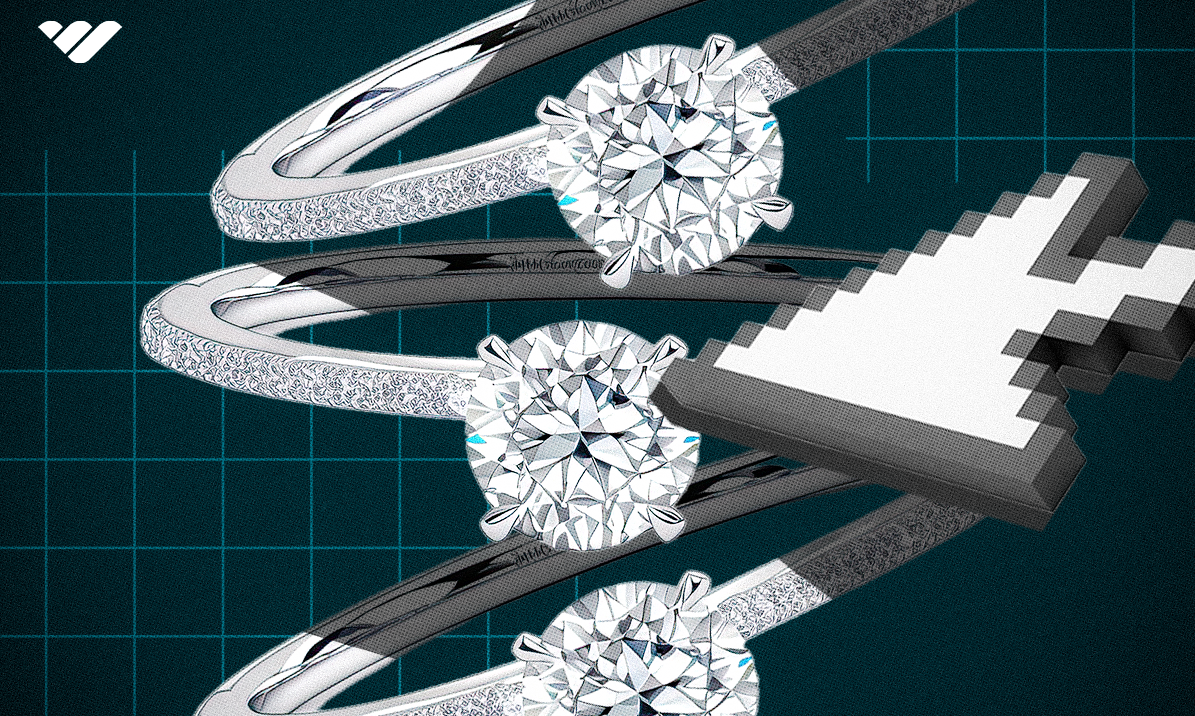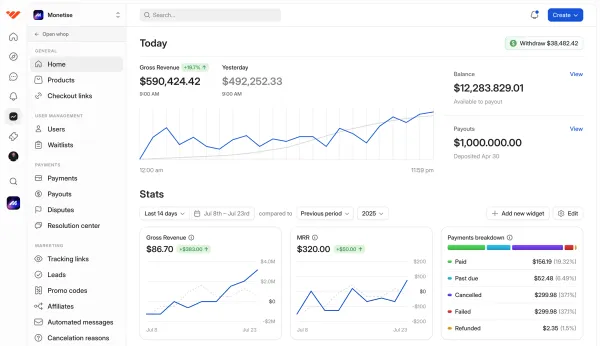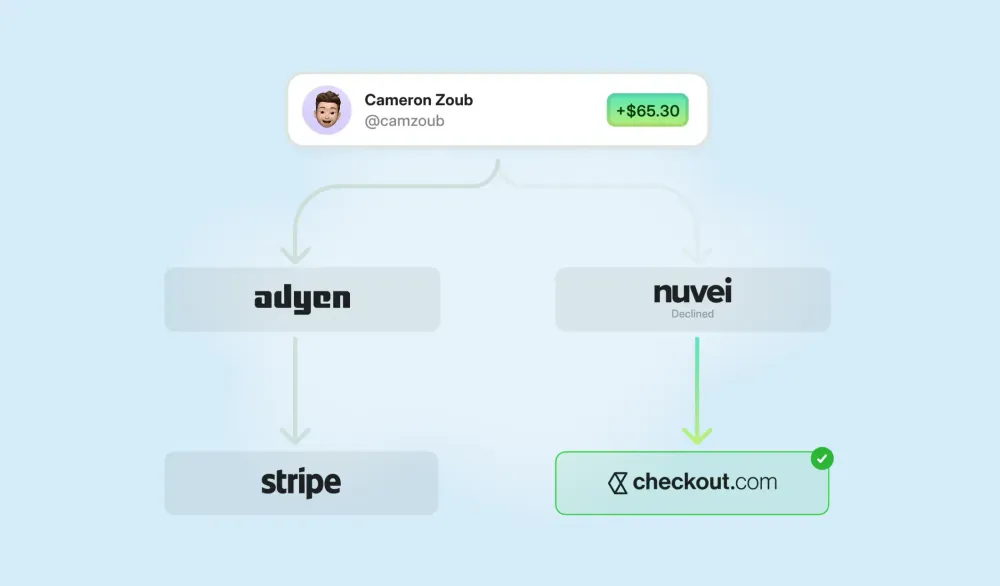Discover where to sell jewelry online for every niche, from handmade to luxury pieces. Compare top marketplaces, fees, and features to find the best fit for your business.
Key takeaways
- Non-luxury brands capture 89% of U.S. jewelry sales, making affordable pieces profitable.
- The global jewelry market will grow from $228 billion to $307 billion by 2026.
- Etsy charges $0.20 listing fee plus 6.5% transaction fee for handmade jewelry sales.
- Amazon Handmade takes 15% referral fee but charges no monthly fees for artisans.
- Facebook Marketplace offers fee-free local jewelry sales for individual sellers.
Gone are the days when jewelry was an exclusive item that only the wealthiest could afford. Today, jewelry is a versatile product to sell, with pieces being made with different designs and from different materials—making its pricing flexible and catering to all tastes and niches.
Just to give you an idea, in the US approximately 89% of jewelry sales go to non-luxury brands (according to Statista). This means that you can make good profits selling more affordable handcrafted jewelry as well as selling high-value luxury pieces.
And if you want to start an online jewelry business, no matter what niche you choose, the right marketplace can make all the difference in the success of your brand.
So, want to learn where to sell jewelry online for max profits? Keep reading and find out.
Why sell jewelry online in the first place?
Selling jewelry can be a very lucrative business that is not limited to physical jewelry stores, as many people think. Medium-sized businesses and even individual sellers can enter the jewelry market by filling specific niches that the segment has, such as low-value jewelry or handmade jewelry.
Let's take a closer look at some good reasons to sell jewelry online:
High profit margins
According to Statista, in 2020, the global jewelry market was valued at approximately 228 billion U.S. dollars and is forecast to reach a value of 307 billion in 2026.
This constant growth is no surprise, jewelry is simply a very profitable product—even lower-value pieces, such as costume jewelry and handmade jewelry, generate high conversion rates in any online store.
Platforms like Etsy (which we will talk about later) always have handmade and vintage jewelry as some of their best-selling products.
And we don't even need to talk much about luxury jewelry. With pieces worth thousands of dollars, many jewelry stores hit quarterly sales goals by selling just a few pieces in a single month.
High demand and universal appeal
Jewelry is a timeless product with universal appeal that can appeal to a variety of audiences across many demographics. Whether for formal events, social gatherings, or just for everyday wear, jewelry always has a place in most consumer’s look.
No matter how much time passes or how trends change, jewelry remains in demand year-round.
Diverse market niches
As mentioned earlier, the jewelry market can be quite flexible, encompassing various styles, materials, and price points. Your business can focus on selling high-value luxury pieces, sustainable jewelry, or even jewelry made with crystals—very popular because of its beauty and affordability.
If you're an entrepreneur with a knack for crafts, there’s also a strong market for handcrafted jewelry. We’re talking about pieces made from recycled components and other materials such as acrylic and even resin.
There are several niches to explore and all of them can generate good profits for your business.
Read our comprehensive guide on the best types of jewelry to sell online to find out more.
Scalability
Selling online means your business has access to a global audience, operational costs are lower compared to physical stores, and because the items are small, shipping jewelry is relatively hassle-free—although security is obviously an extra concern.
Ecommerce usually makes it easier to grow a business because you can start small and expand as your brand grows, without the overhead of a physical storefront. Of course, everything will depend on good planning and your ability to run the business.
Best types of jewelry to sell online
There are many types of jewelry with an almost infinite amount of designs one could choose from. The best part about this is the fact you can focus your business to sell one type of jewelry, or have a style for everyone.
Here are some of the most popular types of jewelry:
- Fine jewelry: High-value items that cater to customers seeking luxury or investment pieces like gold chains, diamond earrings and rings.
- Minimalist jewelry: Sleek, understated designs that appeal to modern buyers seeking versatile and elegant, but modest looking pieces for everyday wear. Examples include dainty necklaces, thin rings, and small hoop earrings.
- Handmade or artisan jewelry: Unique, handcrafted pieces that resonate with shoppers looking for one-of-a-kind exclusive pieces. Can be wire-wrapped gemstones, polymer clay earrings, or woven bead bracelets.
- Sustainable jewelry: Growing environmental awareness makes sustainable products highly appealing. More and more buyers are willing to pay high prices for recycled metal pieces or jewels manufactured from reused materials.
- Boho Jewelry: Often incorporates natural materials like wood, leather, shells, and semi-precious stones, making beautiful and affordable pieces for nature-enthusiasts
- Engraved jewelry: Jewelry such as rings, bracelets, or necklace pendants made specifically to contain engravings of the names of loved ones or specific messages. Very popular because they offer a personal element to the item.
Where to sell jewelry online
When looking for the best place to sell jewelry online you need to consider the audience your business is targeting as well as the features the platform offers that can help with your operation.
Also, evaluate the pricing and any possible fees the marketplace may have, making sure it fits with your current resources.
Here are some of the best marketplaces to sell jewelry online:
1. Etsy
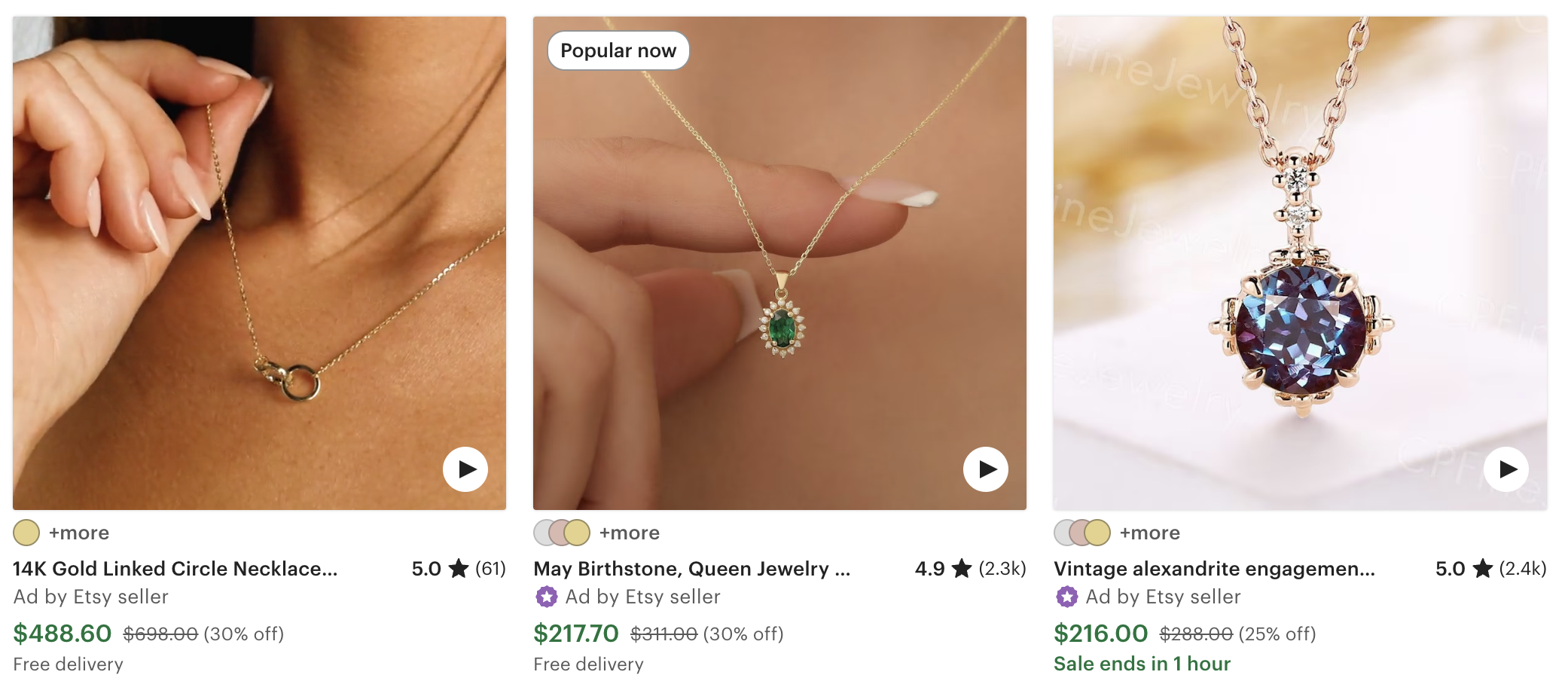
With 95.1 million active buyers, Etsy is one of the leading online marketplaces for vintage and handmade items. It is a perfect marketplace for selling vintage, handmade, and low-cost jewelry.
Another popular product to sell on the platform is engraved jewelry, with buyers having the option to choose the messages they want engraved on the jewelry when purchasing.
However, Etsy is best known as a platform for more affordable items, so high-value fine jewelry—even if it's vintage—may not sell well here.
- Best for: Handmade, vintage, and engraved jewelry.
- Fees: Listing fee of $0.20 per item, plus 6.5% transaction fee.
2. Amazon Handmade
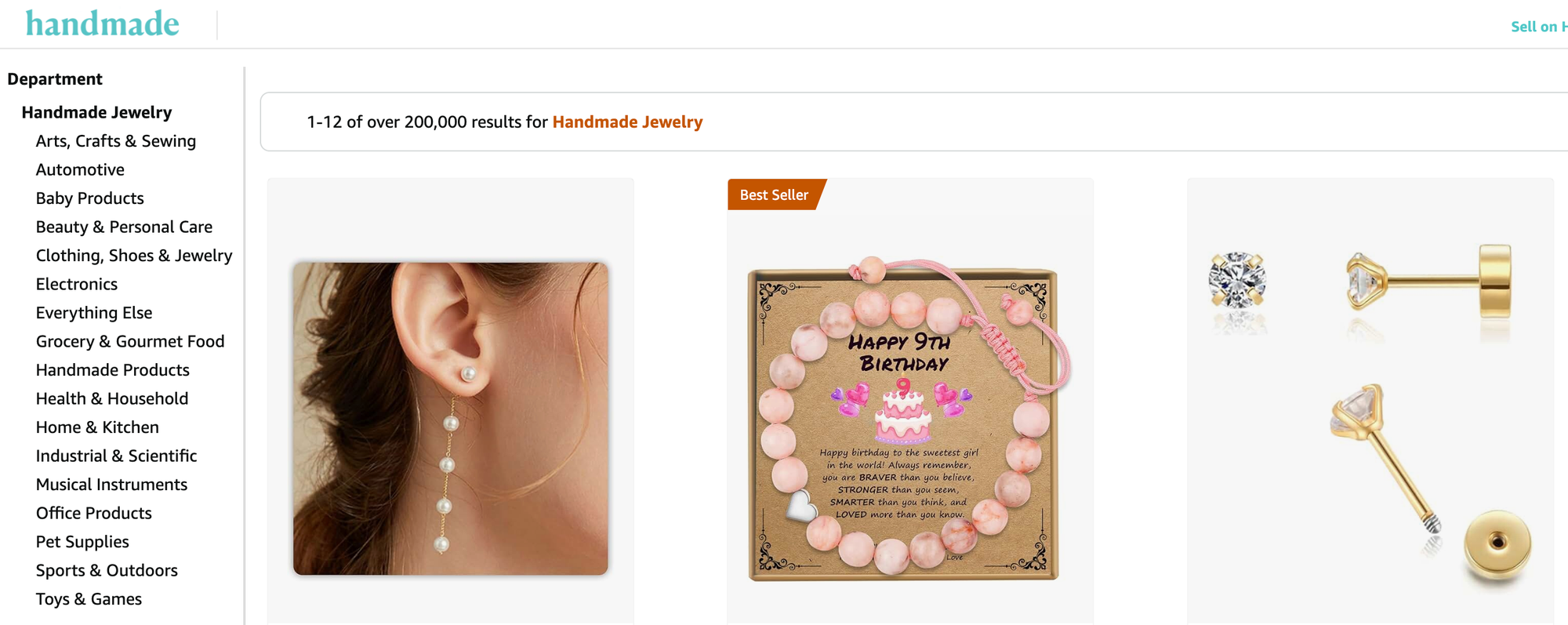
Amazon Handmade is a sales page within Amazon dedicated to creators, artisans, and people looking to buy and sell customizable and unique items.
It’s the perfect space to sell handmade jewelry and costume jewelry, taking advantage of Amazon's huge user base, as well as unique features that Amazon sellers have, such as Amazon FBA.
To be part of Amazon Handmade, you must already be registered as an Amazon seller and sign up for the Amazon Handmade program; if accepted, you can classify and list your products.
It’s a great tool for businesses focused on producing customized and handmade jewelry, although it doesn’t go beyond this niche in the jewelry market.
- Best for: Custom and handmade pieces targeting a broad audience.
- Fees: 15% referral fee; no monthly fee for artisans.
3. eBay
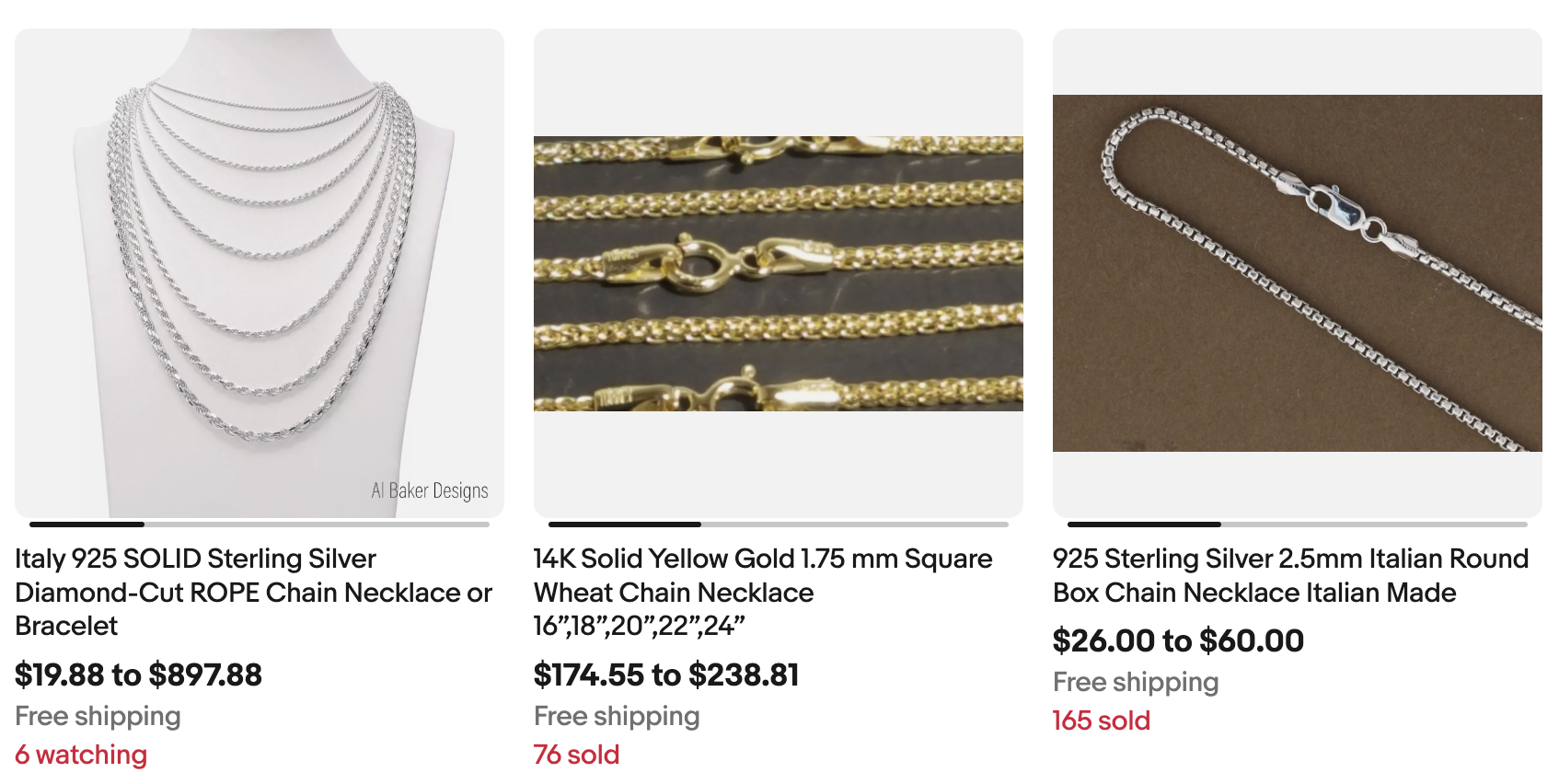
eBay is one of the leading online retail marketplaces and is known for its versatility, where you can sell just about anything, and the same goes for jewelry. From luxury jewelry to second-hand and affordable items, you can target any niche and find buyers. This is as long as you’re willing to put up with some stiff competition.
The good news is that many online jewelry buyers come to eBay looking for great deals. And with the auction system, you can maximize your profits, especially if your business offers unique and rare jewelry.
- Best for: All types of jewelry, but vintage or exclusive pieces are preferable for good profits.
- Fees: Final value fee ranging from 10-15%, depending on the category.
4. Amazon (traditional marketplace)
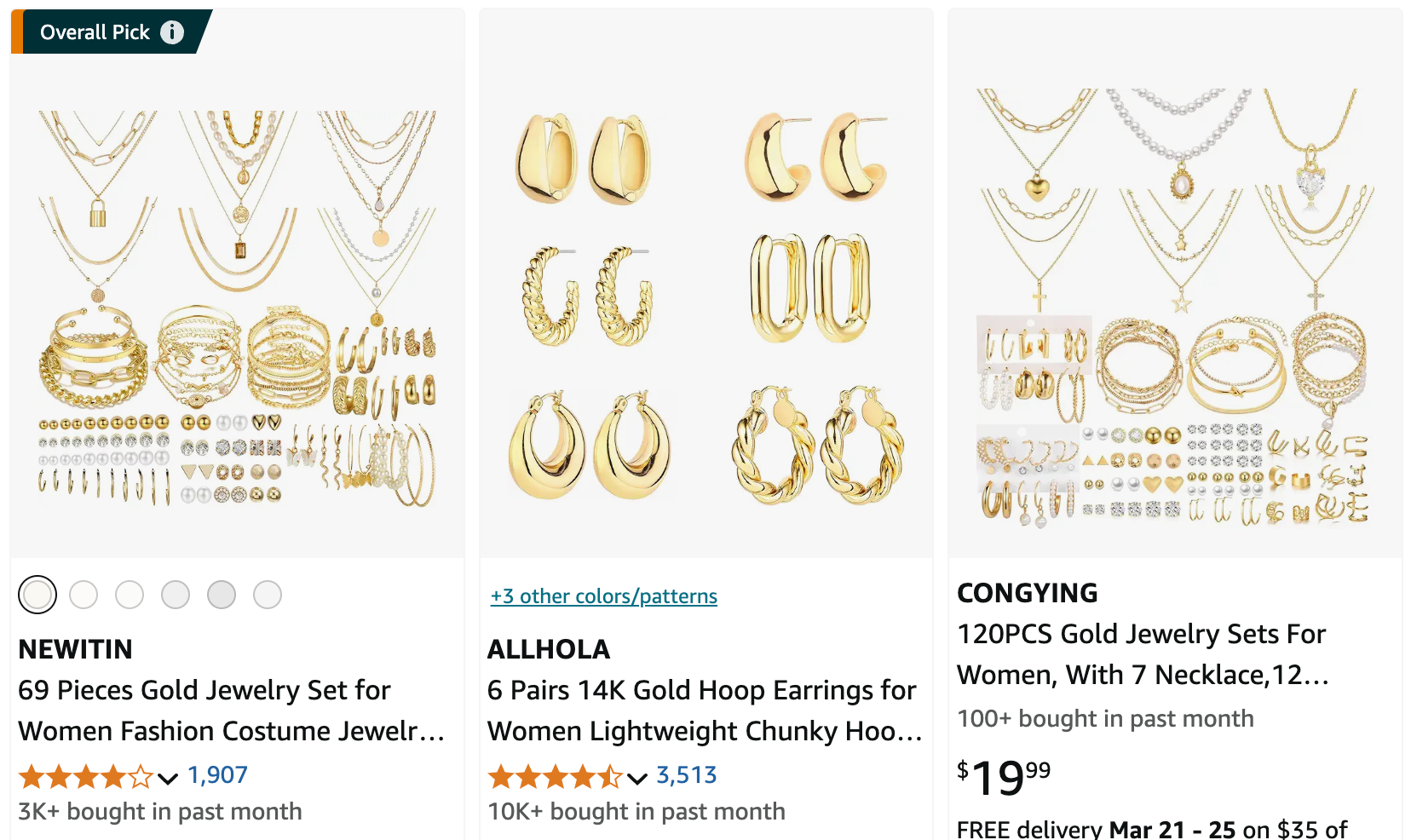
Although it is best known for selling electronics and novelties in general, Amazon is also a great marketplace for selling mass-produced jewelry, such as necklaces, bracelets, and earrings.
- Best for: Mass-produced or branded jewelry lines.
- Fees: 20% of total sales price up to $250, 5% of any portion of total sales greater than $250
5. Poshmark
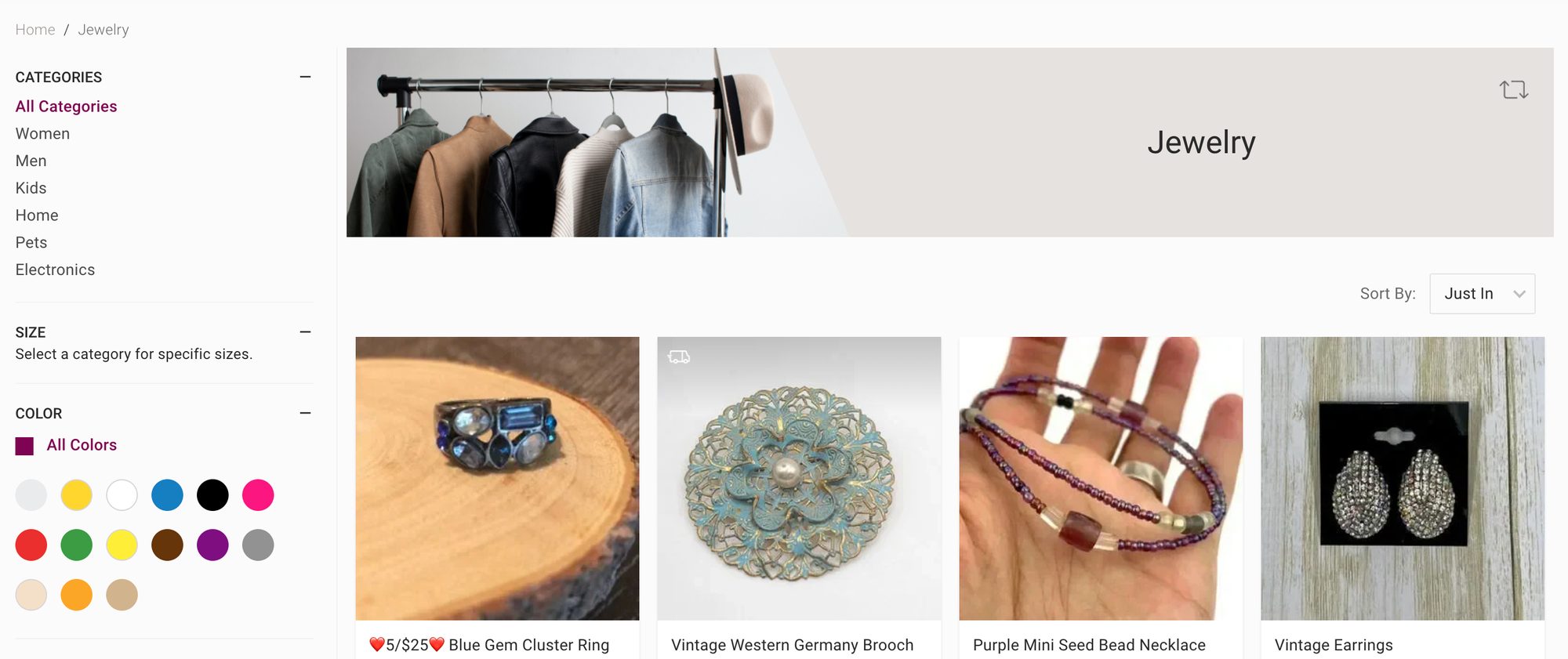
Poshmark is a marketplace that combines elements of social media, such as the ability to like, comment, and share product listings, as well as follow seller profiles.
It’s a platform that focuses heavily on fashion and accessories, with its user base always on the lookout for new pieces, so there’s a strong demand for all types of jewelry such as bracelets, rings, and earrings, whether new or used.
- Best for: Pre-owned, new, and trendy jewelry.
- Fees: For all sales under $15, Poshmark takes a flat commission of $2.95. You keep the rest. For sales of $15 or more, you keep 80% of your sale and Poshmark's commission is 20%.
6. Facebook Marketplace
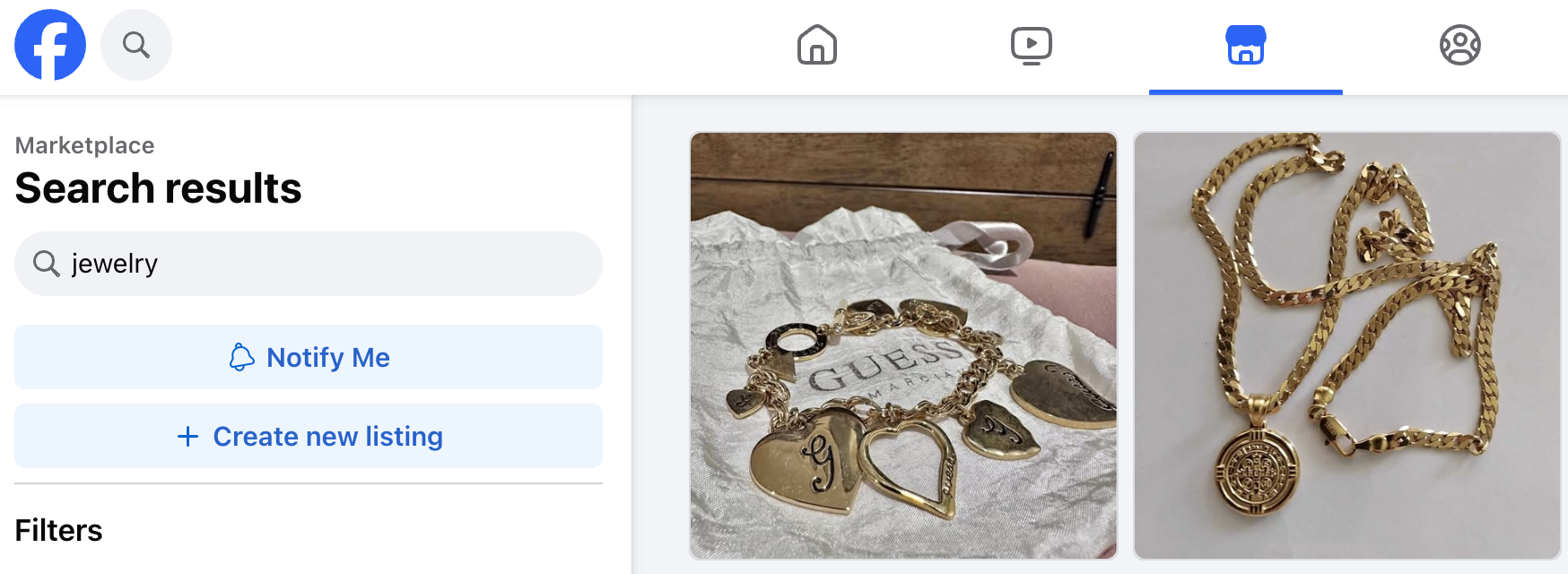
For individual sellers or businesses that want to focus on local sales, Facebook Marketplace is one of the best options. It is a sales platform within Facebook where any Facebook user can list items and sell them, making it perfect for selling second-hand jewelry.
One of the biggest advantages of Facebook Marketplace is that there are no sales fees for items that are shipped by the seller. There is a fee when using shipping services, but this service is not available in many countries — so it's a great way to make money online with physical goods.
- Best for: Affordable and casual jewelry.
- Fees: Free. When using shipping it’s 5% per transaction or a flat fee of $0.40 for items $8 or less.
7. Ruby Lane
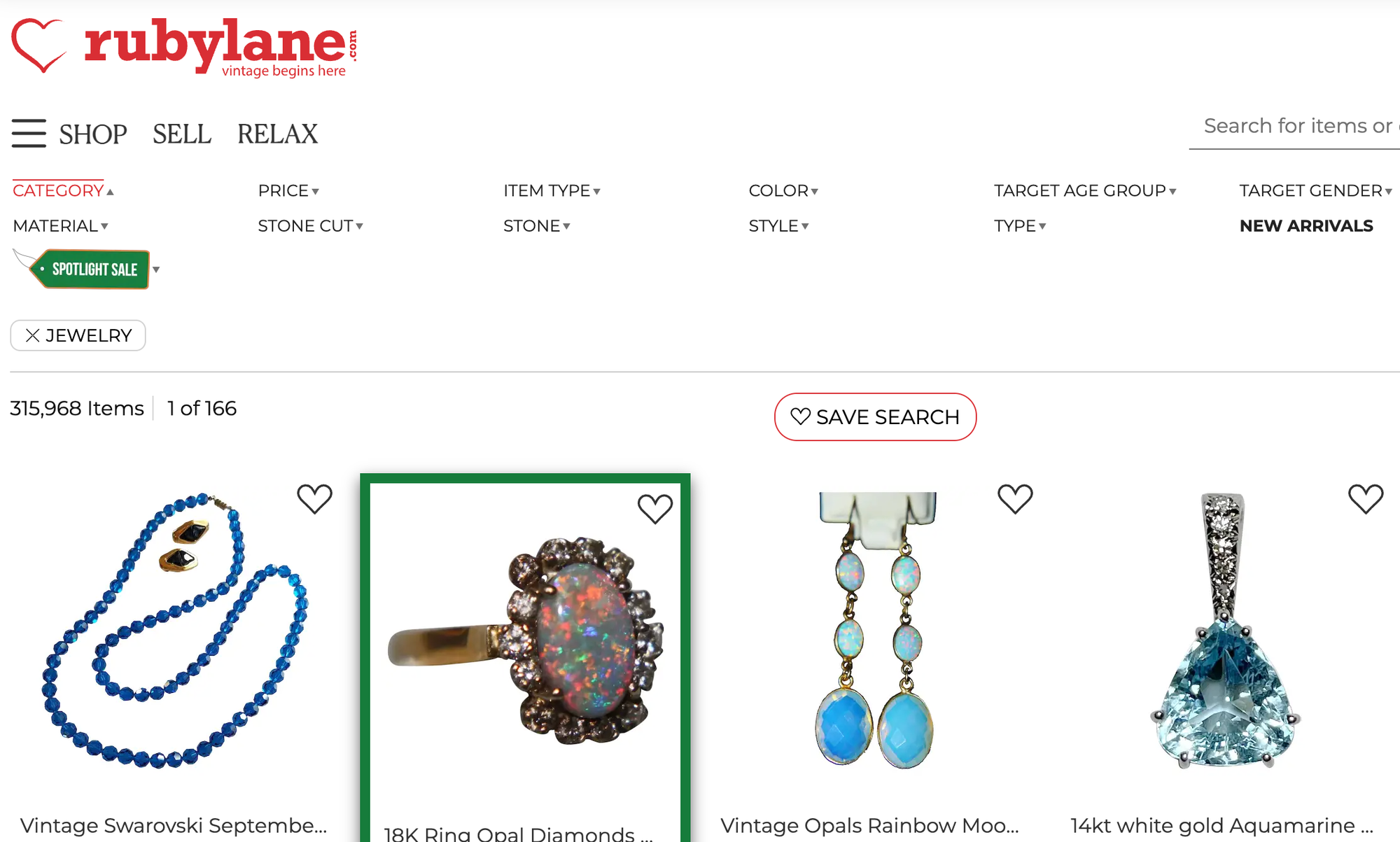
Ruby Lane is a platform specializing in the purchase and sale of home decor, art, fashion, and jewelry. It's considered one of the largest online retailers of vintage and antique items.
The main focus is on high-value artisan jewelry, as well as antique and vintage jewelry, making it an excellent space to sell rare pieces with bold and elegant designs.
Despite not having listing fees, Ruby Lane charges a fixed monthly fee as well as a fee per sale that varies depending on the value of the product which can be costly for smaller businesses.
- Best for: Antique and vintage jewelry.
- Fees: $45 monthly fee, plus 9.9% on the total amount of the sale up to $2,500, calculated per item. 5.0% on the portion of the sale over $2,500 up to $7,500. Or 2.5% on the portion of the sale exceeding $7,500.
8. Bonanza
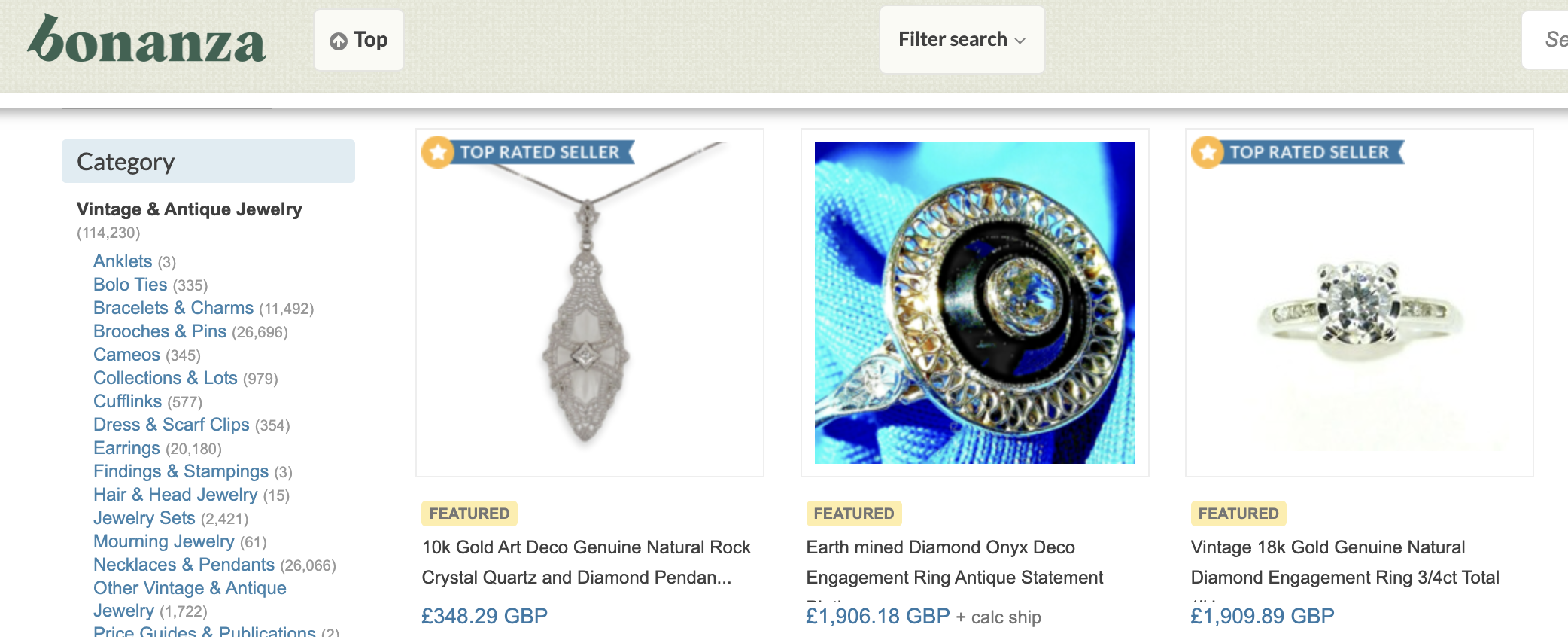
Bonanza is a marketplace known for its flexibility and ease of use.
It is a platform that appeals to all jewelry niches and one of its great advantages is the ability to import product listings from other marketplaces such as eBay, Amazon, Etsy, and even Shopify, making it a great option if you intend to sell on multiple platforms.
It’s also one of the most affordable marketplaces to sell despite not being as popular as other platforms.
- Best for: All niches, preferably unique and custom jewelry pieces.
- Fees: Bonanza charges a flat-rate transaction fee of 25¢ ($0.25) on all completed sales
9. The RealReal
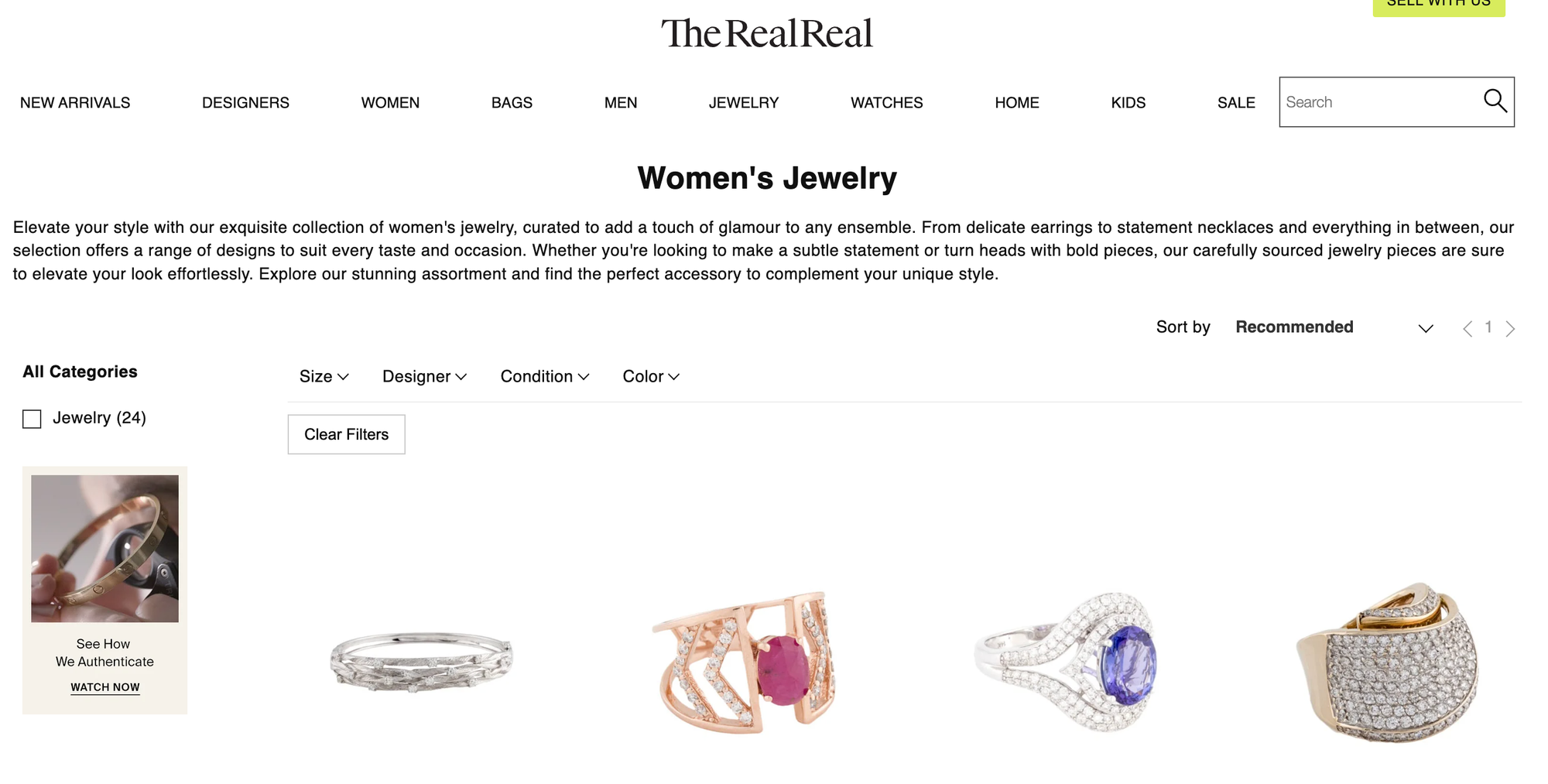
The RealReal is one of the world's largest online marketplace for authenticated, resale luxury jewelry and other fine goods.
It has a rigorous authentication process overseen by experts, providing a safe and reliable platform for users to buy and sell their luxury jewelry and other items.
It is a platform that focuses on high-quality, high-value products, so jewelry in other niches is not accepted on The RealReal.
- Best for: Fine and luxury jewelry
- Fees: On The RealReal, your earnings will depend on your "status" on the platform and the sales value of your items. Trendsetter sellers (the most basic) can receive a commission of up to 70% for sales above $750. While VIP sellers (the highest) receive a commission of 75% for sales above $750. Amounts may be lower for sales below this number.
10. 1stDibs
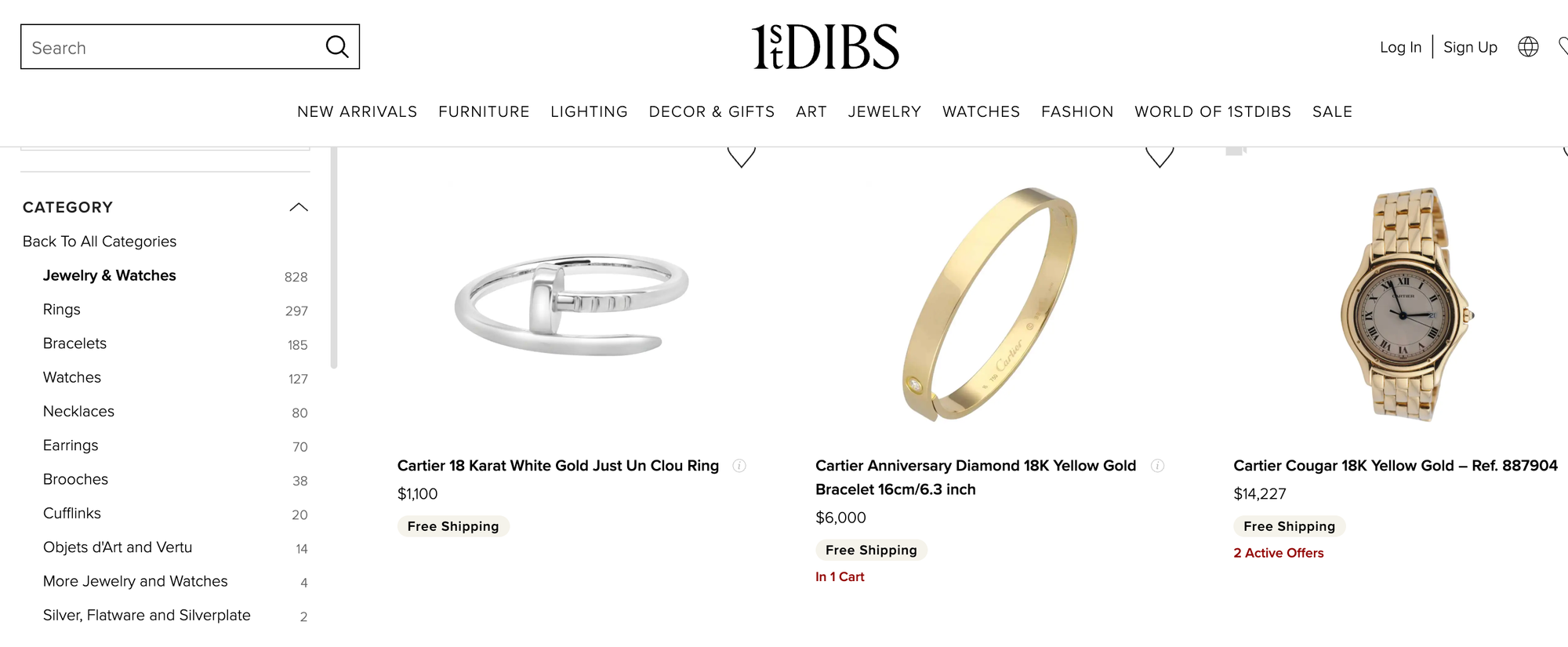
1stDibs is a luxury marketplace specializing in high-end goods, including fine jewelry, art, and furniture. The platform connects sellers with affluent buyers who are willing to invest in authentic, rare, and designer pieces and pay top dollar for it.
1stDibs values, above all else, its reputation as an upscale marketplace; so, to sell on the platform, you need to meet rigorous standards.
- Best for: Fine and luxury jewelry.
- Fees: You pay a monthly fee for selling on 1stDibs that can vary depending on the components of a given membership plan.
11. Vestiaire Collective
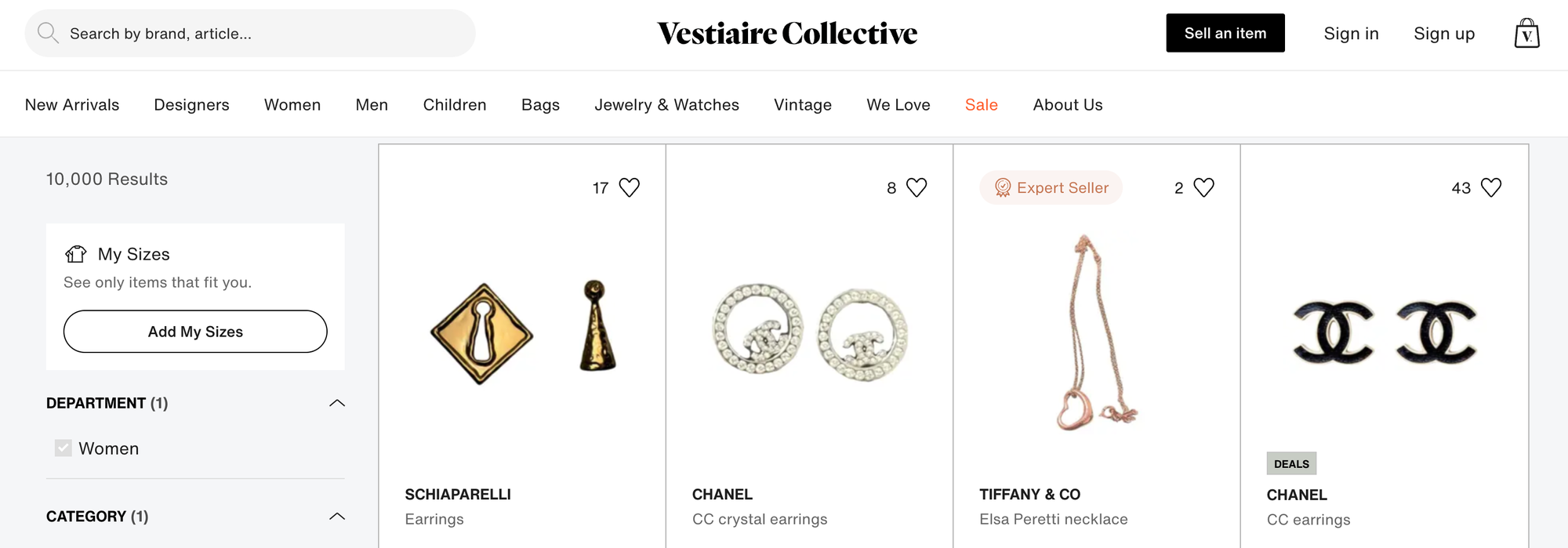
Vestiaire Collective is a global marketplace specializing in secondhand luxury fashion and accessories, including fine and designer jewelry.
It’s quite similar to 1stDibs when it comes to the authentication process that ensures buyers receive genuine goods, but the platform’s focus on sustainable jewelry and circular fashion resonates with eco-conscious shoppers and makes it more accessible even for smaller companies.
- Best for: New or secondhand luxury jewelry. Sustainable jewelry.
- Fees: There aren’t listing fees, instead Vestiaire Collective take 10% of the value for each sale.
Discover more ways to make money online with Whop
Selling jewelry online is indeed a very profitable business, but there are many other opportunities to make money online and some of them can even give you passive income.
On Whop, you will find hundreds of courses and communities designed to teach you how to take advantage of all these opportunities. Imagine making money just from referrals with affiliate marketing, or using drop shipping to your advantage.
Perhaps you could become an affiliate marketer for jewelry dealers, or learn how to create attractive ecommerce pages for your very own jewelry designs!
The opportunities are endless with Whop—there are communites full of experts and other like minded individuals sharing their winning strategies when it comes to making money online. Ready to join them?
Explore Whop and make your dreams come true!
FAQs
How do I price my jewelry?
Consider the cost of materials, labor, marketplace fees, and your desired profit margin. Research similar items to ensure competitive pricing, and leave room for promotions or discounts.
Is it better to sell jewelry on a marketplace or my own website?
Marketplaces can give you access to a ready-made audience, while your own website allows you full control over branding. Starting with a marketplace is often easier for beginners because you don’t need to worry about generating traffic compared to having your own website. It all depends on your experience and long-term planning.


